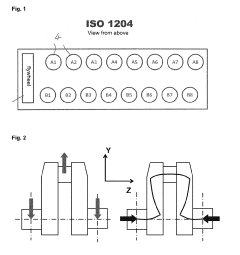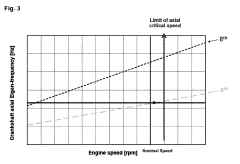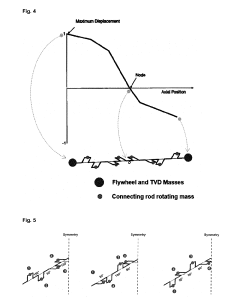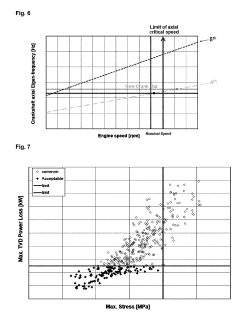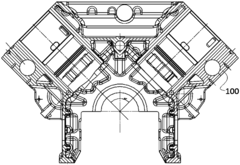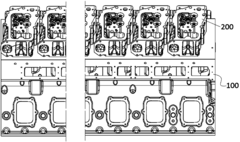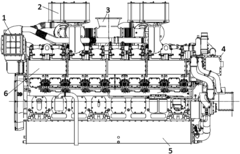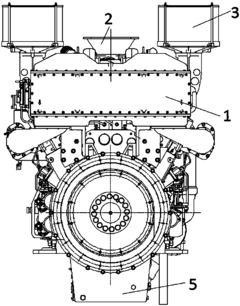The role of V16 engines in luxury automotive history and brand identity
AUG 15, 20258 MIN READ
Generate Your Research Report Instantly with AI Agent
Patsnap Eureka helps you evaluate technical feasibility & market potential.
V16 Engine Evolution
The evolution of V16 engines in luxury automotive history is a testament to engineering prowess and brand prestige. The journey began in the early 20th century when automotive manufacturers sought to push the boundaries of power and refinement. The V16 configuration emerged as the pinnacle of engine design, offering unparalleled smoothness and power delivery.
In the 1930s, Cadillac introduced its iconic V16 engine, setting a new standard for luxury automobiles. This 452 cubic inch (7.4-liter) powerplant produced an impressive 165 horsepower, a remarkable figure for its time. The engine's smooth operation and abundant torque quickly became synonymous with ultimate luxury and exclusivity.
Marmon, another American automaker, followed suit with its own V16 engine in 1931. The Marmon Sixteen boasted an all-aluminum construction, making it significantly lighter than its competitors. This innovative approach to weight reduction showcased the potential for advanced materials in high-performance engine design.
European manufacturers also embraced the V16 configuration. Rolls-Royce developed a prototype V16 engine in the 1930s, although it never reached production. The engine's development, however, contributed valuable insights to the company's engineering expertise.
As automotive technology progressed, the focus shifted towards more compact and efficient engine designs. The V16 configuration became less prevalent in the post-war era, with manufacturers opting for V8 and V12 engines that offered a balance of power and practicality.
However, the allure of the V16 engine persisted in the realm of concept cars and limited-edition models. In 2003, Cadillac unveiled the Sixteen concept car, featuring a modern interpretation of the V16 engine. This 13.6-liter powerplant produced an astounding 1,000 horsepower, reigniting interest in the iconic configuration.
The evolution of V16 engines demonstrates the cyclical nature of automotive innovation. While practical considerations led to their decline in regular production, the V16 configuration continues to hold a special place in automotive history. It represents the pinnacle of engineering achievement and serves as a symbol of ultimate luxury and exclusivity.
Today, the legacy of V16 engines lives on through brand heritage and limited-edition models. Luxury automakers occasionally revisit the V16 concept to showcase their engineering capabilities and pay homage to their storied past. This evolution underscores the enduring appeal of the V16 engine as a hallmark of automotive excellence and a powerful tool for brand differentiation in the luxury market.
In the 1930s, Cadillac introduced its iconic V16 engine, setting a new standard for luxury automobiles. This 452 cubic inch (7.4-liter) powerplant produced an impressive 165 horsepower, a remarkable figure for its time. The engine's smooth operation and abundant torque quickly became synonymous with ultimate luxury and exclusivity.
Marmon, another American automaker, followed suit with its own V16 engine in 1931. The Marmon Sixteen boasted an all-aluminum construction, making it significantly lighter than its competitors. This innovative approach to weight reduction showcased the potential for advanced materials in high-performance engine design.
European manufacturers also embraced the V16 configuration. Rolls-Royce developed a prototype V16 engine in the 1930s, although it never reached production. The engine's development, however, contributed valuable insights to the company's engineering expertise.
As automotive technology progressed, the focus shifted towards more compact and efficient engine designs. The V16 configuration became less prevalent in the post-war era, with manufacturers opting for V8 and V12 engines that offered a balance of power and practicality.
However, the allure of the V16 engine persisted in the realm of concept cars and limited-edition models. In 2003, Cadillac unveiled the Sixteen concept car, featuring a modern interpretation of the V16 engine. This 13.6-liter powerplant produced an astounding 1,000 horsepower, reigniting interest in the iconic configuration.
The evolution of V16 engines demonstrates the cyclical nature of automotive innovation. While practical considerations led to their decline in regular production, the V16 configuration continues to hold a special place in automotive history. It represents the pinnacle of engineering achievement and serves as a symbol of ultimate luxury and exclusivity.
Today, the legacy of V16 engines lives on through brand heritage and limited-edition models. Luxury automakers occasionally revisit the V16 concept to showcase their engineering capabilities and pay homage to their storied past. This evolution underscores the enduring appeal of the V16 engine as a hallmark of automotive excellence and a powerful tool for brand differentiation in the luxury market.
Luxury Car Market Trends
The luxury car market has been experiencing significant shifts in recent years, driven by changing consumer preferences, technological advancements, and global economic factors. One notable trend is the increasing demand for sustainable and environmentally friendly luxury vehicles. As environmental consciousness grows among affluent consumers, luxury automakers are investing heavily in electric and hybrid powertrains, with many brands committing to fully electrified lineups in the coming decades.
Another key trend is the rising importance of digital technology and connectivity in luxury vehicles. High-end car buyers now expect advanced infotainment systems, autonomous driving capabilities, and seamless integration with their digital lives. This has led to partnerships between luxury car manufacturers and tech companies to develop cutting-edge features and user interfaces.
Personalization and customization have become crucial differentiators in the luxury car segment. Buyers are seeking unique, bespoke experiences that reflect their individual tastes and lifestyles. This has resulted in an expansion of customization options, from exterior finishes to interior materials and even personalized driving modes.
The luxury SUV market continues to grow rapidly, with many traditional luxury sedan manufacturers expanding their SUV offerings. This trend reflects changing consumer preferences for versatile, spacious vehicles that combine luxury with practicality. As a result, the lines between luxury car segments are blurring, with crossovers and SUVs becoming increasingly popular among luxury buyers.
Emerging markets, particularly in Asia, are playing a significant role in shaping luxury car trends. China, in particular, has become a crucial market for luxury automakers, influencing design choices and feature sets to cater to local preferences. This has led to the development of long-wheelbase versions of luxury sedans and increased focus on rear-seat comfort and amenities.
The concept of luxury is evolving, with a shift towards experiential luxury rather than just material possessions. This has prompted luxury car brands to offer exclusive events, driving experiences, and concierge services to enhance the overall ownership experience and build stronger emotional connections with their customers.
Lastly, there is a growing interest in heritage and nostalgia within the luxury car market. Many brands are revisiting their iconic models and design elements, creating modern interpretations that blend classic aesthetics with contemporary technology. This trend appeals to both long-time enthusiasts and younger buyers seeking authenticity and timeless design in their luxury vehicles.
Another key trend is the rising importance of digital technology and connectivity in luxury vehicles. High-end car buyers now expect advanced infotainment systems, autonomous driving capabilities, and seamless integration with their digital lives. This has led to partnerships between luxury car manufacturers and tech companies to develop cutting-edge features and user interfaces.
Personalization and customization have become crucial differentiators in the luxury car segment. Buyers are seeking unique, bespoke experiences that reflect their individual tastes and lifestyles. This has resulted in an expansion of customization options, from exterior finishes to interior materials and even personalized driving modes.
The luxury SUV market continues to grow rapidly, with many traditional luxury sedan manufacturers expanding their SUV offerings. This trend reflects changing consumer preferences for versatile, spacious vehicles that combine luxury with practicality. As a result, the lines between luxury car segments are blurring, with crossovers and SUVs becoming increasingly popular among luxury buyers.
Emerging markets, particularly in Asia, are playing a significant role in shaping luxury car trends. China, in particular, has become a crucial market for luxury automakers, influencing design choices and feature sets to cater to local preferences. This has led to the development of long-wheelbase versions of luxury sedans and increased focus on rear-seat comfort and amenities.
The concept of luxury is evolving, with a shift towards experiential luxury rather than just material possessions. This has prompted luxury car brands to offer exclusive events, driving experiences, and concierge services to enhance the overall ownership experience and build stronger emotional connections with their customers.
Lastly, there is a growing interest in heritage and nostalgia within the luxury car market. Many brands are revisiting their iconic models and design elements, creating modern interpretations that blend classic aesthetics with contemporary technology. This trend appeals to both long-time enthusiasts and younger buyers seeking authenticity and timeless design in their luxury vehicles.
V16 Technical Challenges
The development of V16 engines presented numerous technical challenges that pushed the boundaries of automotive engineering. One of the primary hurdles was the sheer size and weight of these massive powerplants. Engineers had to devise innovative solutions to accommodate the lengthy crankshaft and multiple cylinder banks within the confines of a luxury vehicle's engine bay. This often required extensive redesigns of the vehicle's front-end structure and chassis to ensure proper weight distribution and handling characteristics.
Balancing such a large number of cylinders proved to be another significant challenge. The complex harmonics generated by 16 cylinders firing in sequence demanded sophisticated counterweighting and vibration damping systems. Without proper balancing, the engine would produce unacceptable levels of noise, vibration, and harshness, compromising the luxurious experience expected from high-end automobiles.
Fuel delivery and mixture control presented additional obstacles. Ensuring consistent and efficient fuel distribution across all 16 cylinders required advanced carburetion or fuel injection systems. Early V16 engines often employed multiple carburetors or complex intake manifolds to achieve optimal fuel delivery. As technology progressed, electronic fuel injection systems were developed to provide more precise control over the air-fuel mixture.
Cooling such a large engine posed another technical challenge. The increased heat generated by 16 cylinders necessitated advanced cooling systems with greater capacity and efficiency. Engineers had to design intricate water jackets and oil circulation systems to maintain optimal operating temperatures across the entire engine block and prevent localized hot spots that could lead to component failure.
Lubrication was equally critical in V16 engines. The extended crankshaft and numerous moving parts required a robust oil delivery system to ensure proper lubrication under all operating conditions. This often involved the development of high-capacity oil pumps and sophisticated oil galleries to reach every critical component within the engine.
Manufacturing and assembly processes for V16 engines also presented unique challenges. The complexity of these engines demanded extremely tight tolerances and precision machining techniques. Each component had to be meticulously crafted and assembled to ensure proper fitment and operation, often resulting in significantly higher production costs compared to smaller engines.
Lastly, emissions control became an increasingly important challenge as environmental regulations tightened. The inherent fuel consumption of large-displacement V16 engines made it difficult to meet stringent emissions standards without compromising performance. This ultimately contributed to the decline of V16 engines in modern luxury vehicles, as manufacturers shifted towards more efficient powertrains to meet regulatory requirements while still delivering the expected levels of performance and refinement.
Balancing such a large number of cylinders proved to be another significant challenge. The complex harmonics generated by 16 cylinders firing in sequence demanded sophisticated counterweighting and vibration damping systems. Without proper balancing, the engine would produce unacceptable levels of noise, vibration, and harshness, compromising the luxurious experience expected from high-end automobiles.
Fuel delivery and mixture control presented additional obstacles. Ensuring consistent and efficient fuel distribution across all 16 cylinders required advanced carburetion or fuel injection systems. Early V16 engines often employed multiple carburetors or complex intake manifolds to achieve optimal fuel delivery. As technology progressed, electronic fuel injection systems were developed to provide more precise control over the air-fuel mixture.
Cooling such a large engine posed another technical challenge. The increased heat generated by 16 cylinders necessitated advanced cooling systems with greater capacity and efficiency. Engineers had to design intricate water jackets and oil circulation systems to maintain optimal operating temperatures across the entire engine block and prevent localized hot spots that could lead to component failure.
Lubrication was equally critical in V16 engines. The extended crankshaft and numerous moving parts required a robust oil delivery system to ensure proper lubrication under all operating conditions. This often involved the development of high-capacity oil pumps and sophisticated oil galleries to reach every critical component within the engine.
Manufacturing and assembly processes for V16 engines also presented unique challenges. The complexity of these engines demanded extremely tight tolerances and precision machining techniques. Each component had to be meticulously crafted and assembled to ensure proper fitment and operation, often resulting in significantly higher production costs compared to smaller engines.
Lastly, emissions control became an increasingly important challenge as environmental regulations tightened. The inherent fuel consumption of large-displacement V16 engines made it difficult to meet stringent emissions standards without compromising performance. This ultimately contributed to the decline of V16 engines in modern luxury vehicles, as manufacturers shifted towards more efficient powertrains to meet regulatory requirements while still delivering the expected levels of performance and refinement.
Current V16 Technologies
01 V16 engine design and configuration
V16 engines are large, powerful internal combustion engines with 16 cylinders arranged in a V-shape. These engines are typically used in high-performance vehicles, marine applications, and industrial machinery. The V-configuration allows for a more compact design compared to inline engines with the same number of cylinders, while still providing significant power output.- V16 engine design and configuration: V16 engines are large, powerful internal combustion engines with 16 cylinders arranged in a V-shape. These engines are typically used in high-performance vehicles, marine applications, and industrial machinery. The V-configuration allows for a more compact design compared to inline engines, while still providing significant power output.
- V16 engine applications in vehicles: V16 engines are often employed in luxury and high-performance automobiles, as well as in some specialized vehicles such as racing cars and concept vehicles. These engines provide exceptional power and torque, making them suitable for vehicles that require outstanding performance characteristics.
- Historical development of V16 engines: The development of V16 engines dates back to the early 20th century, with various designs and improvements made over time. Early applications included aircraft engines and luxury automobiles. The evolution of V16 engines has led to increased efficiency, power output, and reliability in modern designs.
- V16 engine control systems and optimization: Modern V16 engines incorporate advanced control systems and optimization techniques to improve performance, fuel efficiency, and emissions. These may include electronic fuel injection, variable valve timing, and sophisticated engine management systems to ensure optimal operation across various operating conditions.
- V16 engine manufacturing and assembly: The production of V16 engines involves complex manufacturing and assembly processes due to their size and intricate design. Specialized tooling, precision machining, and quality control measures are essential to ensure the proper construction and performance of these large engines.
02 V16 engine applications in vehicles
V16 engines are often employed in luxury and high-performance automobiles, as well as in some specialized vehicles such as military tanks and large trucks. These engines provide exceptional power and torque, making them suitable for vehicles that require high output and performance capabilities.Expand Specific Solutions03 Historical development of V16 engines
The development of V16 engines dates back to the early 20th century, with various designs and improvements made over time. Early applications included aircraft engines and high-end automobiles. The evolution of V16 engines has led to increased efficiency, power output, and reliability in modern designs.Expand Specific Solutions04 V16 engine control systems and optimization
Modern V16 engines incorporate advanced control systems and optimization techniques to improve performance, fuel efficiency, and emissions. These may include electronic fuel injection, variable valve timing, and sophisticated engine management systems that monitor and adjust various parameters in real-time.Expand Specific Solutions05 V16 engine cooling and lubrication systems
Due to their large size and high power output, V16 engines require specialized cooling and lubrication systems to maintain optimal operating temperatures and ensure proper component protection. These systems may include advanced coolant circulation, oil cooling, and precision-engineered lubrication channels throughout the engine block and cylinder heads.Expand Specific Solutions
Luxury Automakers Analysis
The V16 engine's role in luxury automotive history and brand identity represents a niche market within the broader automotive industry. This technology, while not widely adopted, has reached a mature stage in its development cycle. The market for V16 engines remains limited, primarily catering to ultra-luxury and high-performance vehicles. Companies like BMW and Toyota have historically explored V16 technology, but its application has been restricted due to factors such as cost, complexity, and environmental concerns. The V16 engine continues to symbolize prestige and engineering prowess, maintaining its significance in brand identity for select luxury automakers, despite its limited commercial viability in modern automotive production.
Mitsubishi Motors Corp.
Technical Solution: Mitsubishi Motors Corporation, while not directly involved in V16 engine production for luxury vehicles, has contributed to the broader narrative of high-performance engines in the automotive industry. Mitsubishi has focused on smaller displacement, high-output engines, particularly in their performance and rally-oriented vehicles. For example, their 4G63 engine, a 2.0-liter inline-four, became legendary in the performance car world, powering vehicles like the Lancer Evolution series[9]. While this approach differs from the luxury-oriented V16 engines, it demonstrates Mitsubishi's capability in engine development and performance engineering. In the context of luxury automotive history, Mitsubishi's contributions have been more indirect, focusing on technology transfer from their motorsport experiences to their higher-end production vehicles[10].
Strengths: Mitsubishi's expertise in high-performance, smaller displacement engines showcases their engineering capabilities, which could potentially be applied to larger, more luxurious engines. Their experience in motorsport has led to innovations that could be relevant to luxury vehicle development. Weaknesses: The lack of direct involvement in V16 or other high-cylinder count luxury engines limits Mitsubishi's relevance in the specific context of V16 engines in luxury automotive history.
GM Global Technology Operations LLC
Technical Solution: General Motors, through its luxury brand Cadillac, has made significant contributions to V16 engine history. In 1930, Cadillac introduced the Series 452 with a 7.4-liter V16 engine, marking the first production V16 engine in a passenger car[3]. This engine produced 165 horsepower and was known for its smoothness and quiet operation. The V16 became a symbol of Cadillac's engineering excellence and luxury status. In 2003, Cadillac revisited the V16 concept with the Sixteen concept car, featuring a 13.6-liter V16 engine producing 1000 horsepower[4]. This modern interpretation of the V16 showcased GM's continued interest in pushing the boundaries of luxury automotive engineering, even if it didn't reach production. The V16 engines have played a crucial role in establishing and reinforcing Cadillac's brand identity as a leader in American luxury automobiles.
Strengths: GM's V16 engines, particularly in Cadillac models, have been instrumental in establishing the brand's luxury credentials and showcasing American engineering prowess. The historical significance of these engines has contributed to a strong brand heritage. Weaknesses: The high cost and complexity of V16 engines limited their practicality for mass production, potentially restricting their impact to concept cars and limited production runs in modern times.
Key V16 Engine Patents
V16 crankstar and firing sequences
PatentActiveUS20190249598A1
Innovation
- The implementation of specific firing sequences and crankshaft designs with lengthwise symmetric or quasi-symmetric crank stars, combined with a torsional vibration damper, to optimize the angular sequence of crank throws and firing intervals, reducing axial and torsional vibrations and enhancing dynamic behavior.
High-power V16 diesel engine
PatentActiveCN108194198A
Innovation
- A high-power V-shaped 16-cylinder diesel engine is designed, which uses a V-shaped cylinder block, 16 single cylinder heads, four turbochargers and an intercooler, combined with a cooling system of high and low temperature water circulation loops, to achieve turbocharging through Technology and classified cooling systems increase air density and lower temperatures to meet the needs of high power and torque.
Environmental Regulations
Environmental regulations have played a significant role in shaping the automotive industry, particularly impacting the development and use of V16 engines in luxury vehicles. These regulations, primarily focused on reducing emissions and improving fuel efficiency, have posed considerable challenges to manufacturers seeking to maintain the prestige and performance associated with V16 engines.
In the early 20th century, when V16 engines were at their peak in luxury automobiles, environmental concerns were not a primary consideration. However, as awareness of air pollution and its effects on public health grew, governments began implementing stricter emissions standards. The Clean Air Act of 1970 in the United States marked a turning point, setting the stage for increasingly stringent regulations worldwide.
These regulations have forced luxury automakers to reconsider their use of large displacement engines, including V16s. The need to meet ever-tightening emissions standards has led to a shift towards smaller, more efficient engines, often utilizing forced induction technologies like turbocharging and supercharging to maintain performance levels while reducing fuel consumption and emissions.
Carbon dioxide emissions targets, particularly in Europe, have further challenged the viability of V16 engines in modern luxury vehicles. The EU's fleet-wide CO2 emissions targets have compelled manufacturers to focus on electrification and downsizing strategies, making it increasingly difficult to justify the production of large, fuel-intensive engines like V16s.
Despite these challenges, some luxury brands have attempted to keep the V16 legacy alive while adapting to regulatory pressures. For instance, Cadillac's Sixteen concept car in 2003 featured a V16 engine with cylinder deactivation technology, allowing it to operate as a V8 or even a V4 under light load conditions to improve fuel efficiency.
The impact of environmental regulations on V16 engines extends beyond their production and use. Vintage vehicles equipped with these engines are also affected by evolving emissions laws, with some cities implementing low emission zones that restrict the use of older, high-emission vehicles in urban areas.
As the automotive industry continues to evolve in response to environmental concerns, the future of V16 engines in luxury vehicles remains uncertain. While their historical significance and brand identity value are undeniable, the pressure to meet increasingly strict environmental standards may relegate V16 engines to limited production runs, concept vehicles, or as part of hybrid powertrains that can offset their environmental impact.
In the early 20th century, when V16 engines were at their peak in luxury automobiles, environmental concerns were not a primary consideration. However, as awareness of air pollution and its effects on public health grew, governments began implementing stricter emissions standards. The Clean Air Act of 1970 in the United States marked a turning point, setting the stage for increasingly stringent regulations worldwide.
These regulations have forced luxury automakers to reconsider their use of large displacement engines, including V16s. The need to meet ever-tightening emissions standards has led to a shift towards smaller, more efficient engines, often utilizing forced induction technologies like turbocharging and supercharging to maintain performance levels while reducing fuel consumption and emissions.
Carbon dioxide emissions targets, particularly in Europe, have further challenged the viability of V16 engines in modern luxury vehicles. The EU's fleet-wide CO2 emissions targets have compelled manufacturers to focus on electrification and downsizing strategies, making it increasingly difficult to justify the production of large, fuel-intensive engines like V16s.
Despite these challenges, some luxury brands have attempted to keep the V16 legacy alive while adapting to regulatory pressures. For instance, Cadillac's Sixteen concept car in 2003 featured a V16 engine with cylinder deactivation technology, allowing it to operate as a V8 or even a V4 under light load conditions to improve fuel efficiency.
The impact of environmental regulations on V16 engines extends beyond their production and use. Vintage vehicles equipped with these engines are also affected by evolving emissions laws, with some cities implementing low emission zones that restrict the use of older, high-emission vehicles in urban areas.
As the automotive industry continues to evolve in response to environmental concerns, the future of V16 engines in luxury vehicles remains uncertain. While their historical significance and brand identity value are undeniable, the pressure to meet increasingly strict environmental standards may relegate V16 engines to limited production runs, concept vehicles, or as part of hybrid powertrains that can offset their environmental impact.
Brand Identity Impact
V16 engines have played a significant role in shaping the brand identity of luxury automotive manufacturers throughout history. These powerful and complex powerplants have become synonymous with prestige, exclusivity, and engineering excellence, contributing to the allure of high-end vehicles and reinforcing the status of their makers.
For luxury car brands, the V16 engine has served as a halo product, showcasing their technological prowess and commitment to pushing the boundaries of automotive engineering. The sheer complexity and rarity of V16 engines have made them a symbol of ultimate luxury, appealing to discerning customers who demand the very best in performance and refinement.
The incorporation of V16 engines into flagship models has helped luxury brands differentiate themselves from mainstream manufacturers, creating a clear distinction in the market. This differentiation has been crucial in establishing and maintaining premium positioning, allowing luxury brands to command higher prices and cultivate a loyal customer base of automotive enthusiasts and affluent buyers.
Moreover, the V16 engine has become an integral part of the heritage and storytelling for several prestigious automotive marques. Brands like Cadillac, Marmon, and Bugatti have leveraged their history with V16 engines to reinforce their legacy of innovation and luxury. This historical connection has been used in marketing campaigns and brand narratives to evoke a sense of nostalgia and continuity, linking modern vehicles to their illustrious predecessors.
The visual impact of a V16 engine has also contributed to brand identity. The sight of a massive, meticulously crafted V16 under the hood of a luxury car serves as a powerful statement of engineering excellence and attention to detail. This visual spectacle has been used by manufacturers to create memorable experiences for customers and enthusiasts, further solidifying the brand's image as a purveyor of exceptional automobiles.
In recent years, as the automotive industry shifts towards electrification, the role of V16 engines in brand identity has evolved. While less common in modern production vehicles, the legacy of V16 engines continues to influence design language and marketing strategies. Luxury brands now face the challenge of translating the prestige and exclusivity associated with V16 engines into new technologies, such as high-performance electric powertrains.
For luxury car brands, the V16 engine has served as a halo product, showcasing their technological prowess and commitment to pushing the boundaries of automotive engineering. The sheer complexity and rarity of V16 engines have made them a symbol of ultimate luxury, appealing to discerning customers who demand the very best in performance and refinement.
The incorporation of V16 engines into flagship models has helped luxury brands differentiate themselves from mainstream manufacturers, creating a clear distinction in the market. This differentiation has been crucial in establishing and maintaining premium positioning, allowing luxury brands to command higher prices and cultivate a loyal customer base of automotive enthusiasts and affluent buyers.
Moreover, the V16 engine has become an integral part of the heritage and storytelling for several prestigious automotive marques. Brands like Cadillac, Marmon, and Bugatti have leveraged their history with V16 engines to reinforce their legacy of innovation and luxury. This historical connection has been used in marketing campaigns and brand narratives to evoke a sense of nostalgia and continuity, linking modern vehicles to their illustrious predecessors.
The visual impact of a V16 engine has also contributed to brand identity. The sight of a massive, meticulously crafted V16 under the hood of a luxury car serves as a powerful statement of engineering excellence and attention to detail. This visual spectacle has been used by manufacturers to create memorable experiences for customers and enthusiasts, further solidifying the brand's image as a purveyor of exceptional automobiles.
In recent years, as the automotive industry shifts towards electrification, the role of V16 engines in brand identity has evolved. While less common in modern production vehicles, the legacy of V16 engines continues to influence design language and marketing strategies. Luxury brands now face the challenge of translating the prestige and exclusivity associated with V16 engines into new technologies, such as high-performance electric powertrains.
Unlock deeper insights with Patsnap Eureka Quick Research — get a full tech report to explore trends and direct your research. Try now!
Generate Your Research Report Instantly with AI Agent
Supercharge your innovation with Patsnap Eureka AI Agent Platform!
